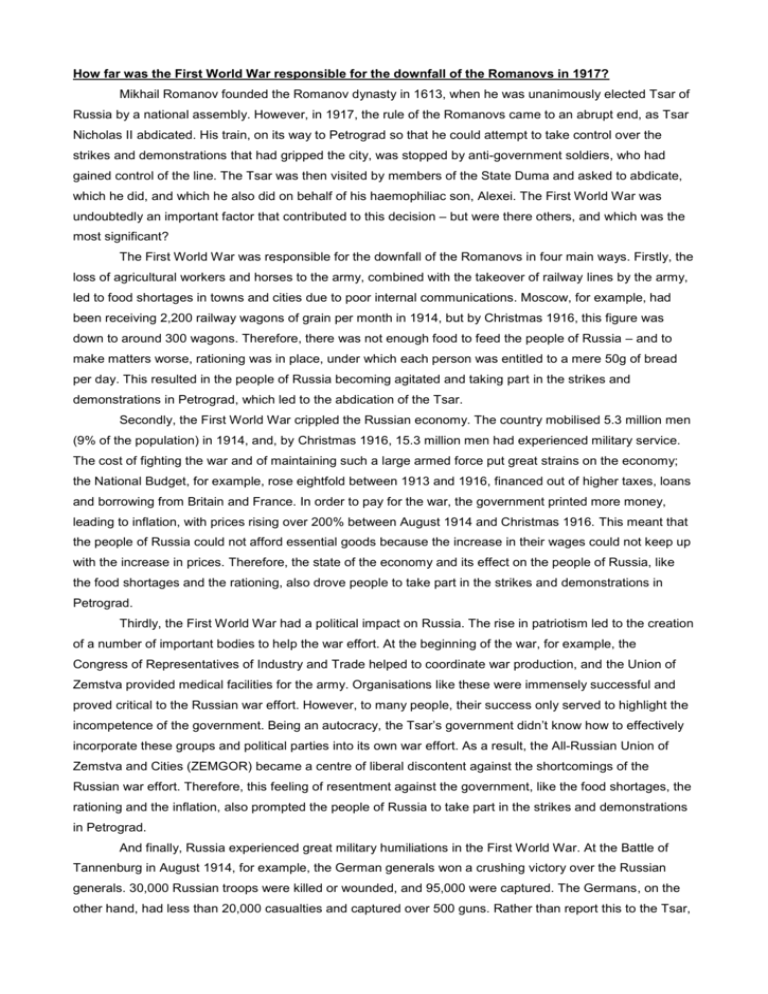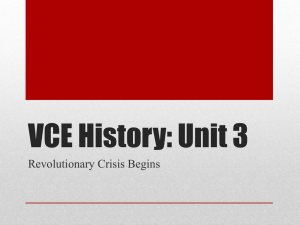How far was the First World War responsible for the
advertisement

How far was the First World War responsible for the downfall of the Romanovs in 1917? Mikhail Romanov founded the Romanov dynasty in 1613, when he was unanimously elected Tsar of Russia by a national assembly. However, in 1917, the rule of the Romanovs came to an abrupt end, as Tsar Nicholas II abdicated. His train, on its way to Petrograd so that he could attempt to take control over the strikes and demonstrations that had gripped the city, was stopped by anti-government soldiers, who had gained control of the line. The Tsar was then visited by members of the State Duma and asked to abdicate, which he did, and which he also did on behalf of his haemophiliac son, Alexei. The First World War was undoubtedly an important factor that contributed to this decision – but were there others, and which was the most significant? The First World War was responsible for the downfall of the Romanovs in four main ways. Firstly, the loss of agricultural workers and horses to the army, combined with the takeover of railway lines by the army, led to food shortages in towns and cities due to poor internal communications. Moscow, for example, had been receiving 2,200 railway wagons of grain per month in 1914, but by Christmas 1916, this figure was down to around 300 wagons. Therefore, there was not enough food to feed the people of Russia – and to make matters worse, rationing was in place, under which each person was entitled to a mere 50g of bread per day. This resulted in the people of Russia becoming agitated and taking part in the strikes and demonstrations in Petrograd, which led to the abdication of the Tsar. Secondly, the First World War crippled the Russian economy. The country mobilised 5.3 million men (9% of the population) in 1914, and, by Christmas 1916, 15.3 million men had experienced military service. The cost of fighting the war and of maintaining such a large armed force put great strains on the economy; the National Budget, for example, rose eightfold between 1913 and 1916, financed out of higher taxes, loans and borrowing from Britain and France. In order to pay for the war, the government printed more money, leading to inflation, with prices rising over 200% between August 1914 and Christmas 1916. This meant that the people of Russia could not afford essential goods because the increase in their wages could not keep up with the increase in prices. Therefore, the state of the economy and its effect on the people of Russia, like the food shortages and the rationing, also drove people to take part in the strikes and demonstrations in Petrograd. Thirdly, the First World War had a political impact on Russia. The rise in patriotism led to the creation of a number of important bodies to help the war effort. At the beginning of the war, for example, the Congress of Representatives of Industry and Trade helped to coordinate war production, and the Union of Zemstva provided medical facilities for the army. Organisations like these were immensely successful and proved critical to the Russian war effort. However, to many people, their success only served to highlight the incompetence of the government. Being an autocracy, the Tsar’s government didn’t know how to effectively incorporate these groups and political parties into its own war effort. As a result, the All-Russian Union of Zemstva and Cities (ZEMGOR) became a centre of liberal discontent against the shortcomings of the Russian war effort. Therefore, this feeling of resentment against the government, like the food shortages, the rationing and the inflation, also prompted the people of Russia to take part in the strikes and demonstrations in Petrograd. And finally, Russia experienced great military humiliations in the First World War. At the Battle of Tannenburg in August 1914, for example, the German generals won a crushing victory over the Russian generals. 30,000 Russian troops were killed or wounded, and 95,000 were captured. The Germans, on the other hand, had less than 20,000 casualties and captured over 500 guns. Rather than report this to the Tsar, General Samsonov shot himself. Also, in September 1915, the Tsar made one of his most disastrous decisions: he dismissed his Uncle Nikolai as commander-in-chief of the army and took command himself, against the advice of his ministers and the Duma chairman Rodzianko. The Tsar was unqualified to command a military unit, let alone an army of several millions. The Brusilov Offensive was another significant failure for Russia. Although it initially met with success, and even prompted Romania to enter the war on Russia’s side, by August 1916 it had run out of momentum, and the Russian forces had to retreat from the Baltic Sea to the Black Sea. By Christmas 1916, 1.6 million Russian soldiers were dead, 3.9 million were wounded and 2.4 million had been taken prisoner. Therefore, Russia’s abysmal performance in the First World War, like the food shortages, the rationing, the inflation and the organisations like ZEMGOR that the Tsar’s government failed to use effectively, also prompted the people of Russia to take part in the strikes and demonstrations in Petrograd. Another factor that contributed to the downfall of the Romanovs was the personal scandals surrounding them, many of which concerned Grigorii Rasputin. Rasputin was a Siberian Orthodox monk and mystic who became involved with the royal family in 1907. He was initially called in because of Alexei, the haemophiliac Tsarevich: Rasputin was believed to have the power of healing, and there is evidence to suggest that indeed he did. By 1914, Rasputin was a regular and significant member of the Court and, in particular, a personal confidant of Alexandra, the Tsarina. His main influence came after the Tsar went to the Front in September 1915, when Alexandra was left to organise the government. Between September 1915 and December 1916, there were constant ministerial changes, many of which were seen as influenced by Rasputin. And as the Russian war effort faltered, more and more blame was put on Alexandra, who, being German, was accused of being in sympathy with the enemy. By December 1916, many royalists wanted to preserve the Tsarist regime through the removal of Rasputin. They were resentful towards him as he was only a peasant, yet had immense influence over Russia, and because of his insatiable sexual appetite and immorality, which involved actresses and prostitutes. Therefore, society’s elite were becoming increasingly disillusioned with the way that the country was being run, posing a serious threat to the Tsarist regime. The defection of the army also contributed to the downfall of the Romanovs, as the strikes and demonstrations in Petrograd could not be put down or even controlled. Tens of thousands of women took to the streets to commemorate International Women’s Day on 23 February 1917, which coincided with a major strike at the Putilov Engineering Words – together, the demonstrators and the strikers numbered over 100,000. The following day, the strikes and demonstrations continued, mainly over the food shortages and the threat of rationing. There were now 200,000 protestors in Petrograd. At first, the Tsar relied on the army to keep control – as in the 1905 Revolution, when the Tsarist regime had survived because of their support – yet their loyalty was to be short-lived. On 25 February 1917, the Cossack troops, who had traditionally been loyal to the Tsar, refused to fire on the protestors. The following day, most of the troops did fire on the protestors, killing 40 of them, but the elite Pavlovsky Life Guards refused to carry out orders. Therefore, the Tsar was beginning to lose control of the army, which placed his regime in danger: the Tsar would no longer be able to rely on their support to control the Empire. This mutiny was worsened by the creation of workers’ soviets. On 1 March 1917, the workers’ soviets that had begun forming on 24 February joined forces to make the Petrograd Soviet – this was similar to the 1905 Revolution, when the St. Petersburg Soviet was created. The Petrograd Soviet issued ‘Order Number One’, which demanded that all officers in the army be elected by their men. This, combined with the mutiny, increased the deterioration of the Tsar’s authority and command over the army. In conclusion, the most significant factor that contributed to the downfall of the Romanovs in 1917 was the First World War. This is because it affected the people of Russia in so many ways: it led to food shortages, rationing and inflation; it created political opposition due to the incompetence of the government; Russia’s abysmal military performance was considered a national humiliation. Therefore, it was ultimately the First World War that caused the strikes and demonstrations in Petrograd. Even though the defection of the army was a massive blow for the Tsar, had the army stayed loyal, it is unlikely that it would have been able to effectively put down or even control the strikes and demonstrations due to the sheer number of protestors. Even if it had, a significant number of people clearly felt very strongly about the issues on which they were protesting, so they would not have been silenced for the long-term. With regard to the personal scandals surrounding the Romanovs, they were not of such significance to the people of Russia in 1917, when they had such great problems of their own to deal with. Therefore, the First World War is the most significant factor that contributed to the downfall of the Romanovs in 1917, simply because it was the root of the intense social unrest that led to the strikes and demonstrations in Petrograd and the abdication of the Tsar.









